Maximizing Cardiac Health through Rehabilitation
VerifiedAdded on 2019/10/30
|12
|3378
|361
Report
AI Summary
The provided content discusses the importance of cardiac rehabilitation in enabling individuals to live a fulfilling life. It highlights the benefits of cardiac rehabilitation, including improved heart function, reduced hospital readmissions, and enhanced patient-centered care. The articles also emphasize the need for personalized approaches to cardiac rehabilitation, taking into account factors such as age, lifestyle, and comorbidities. Furthermore, the content touches on the role of palliative care in supporting patients with chronic heart failure.
Contribute Materials
Your contribution can guide someone’s learning journey. Share your
documents today.
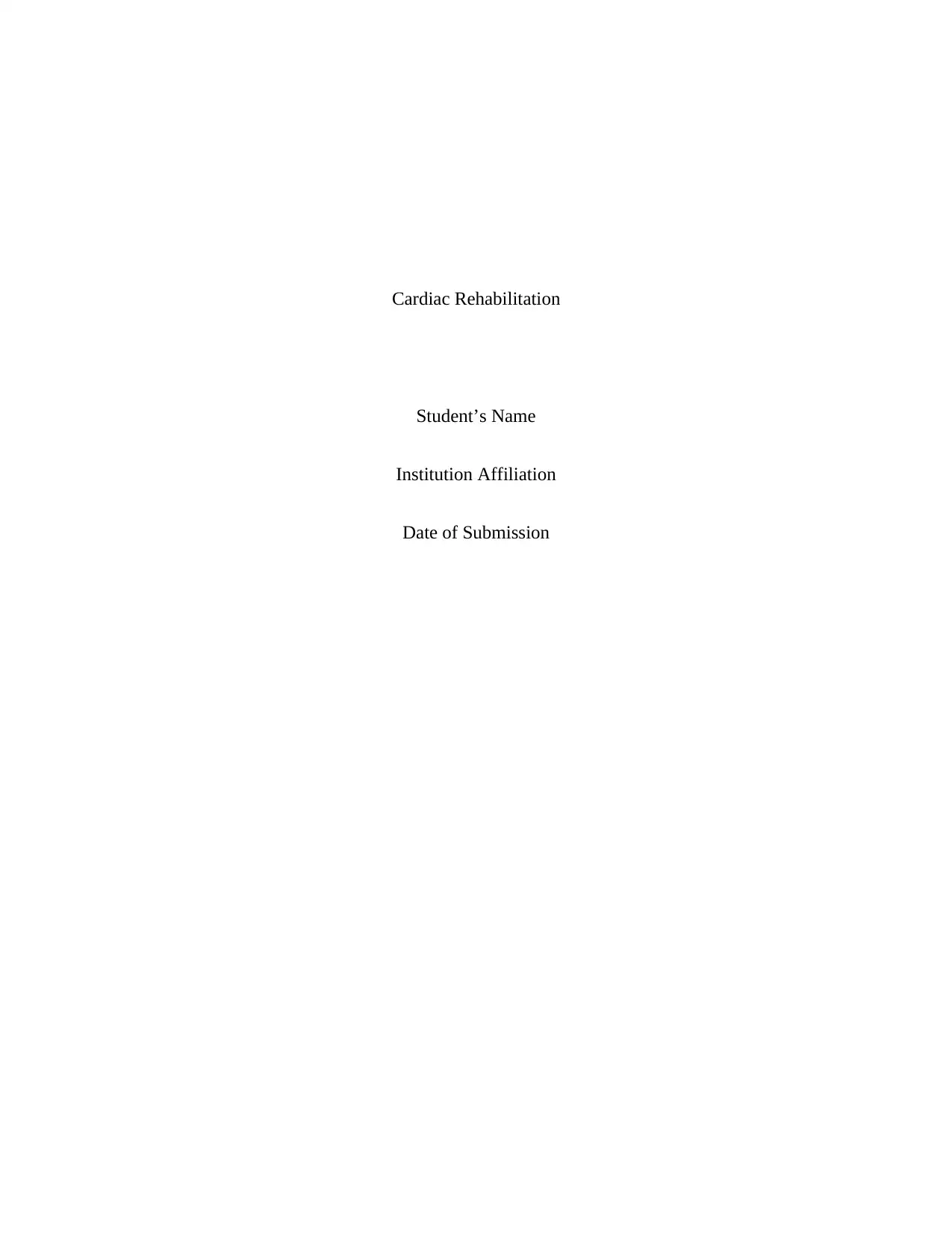
Cardiac Rehabilitation
Student’s Name
Institution Affiliation
Date of Submission
Student’s Name
Institution Affiliation
Date of Submission
Secure Best Marks with AI Grader
Need help grading? Try our AI Grader for instant feedback on your assignments.
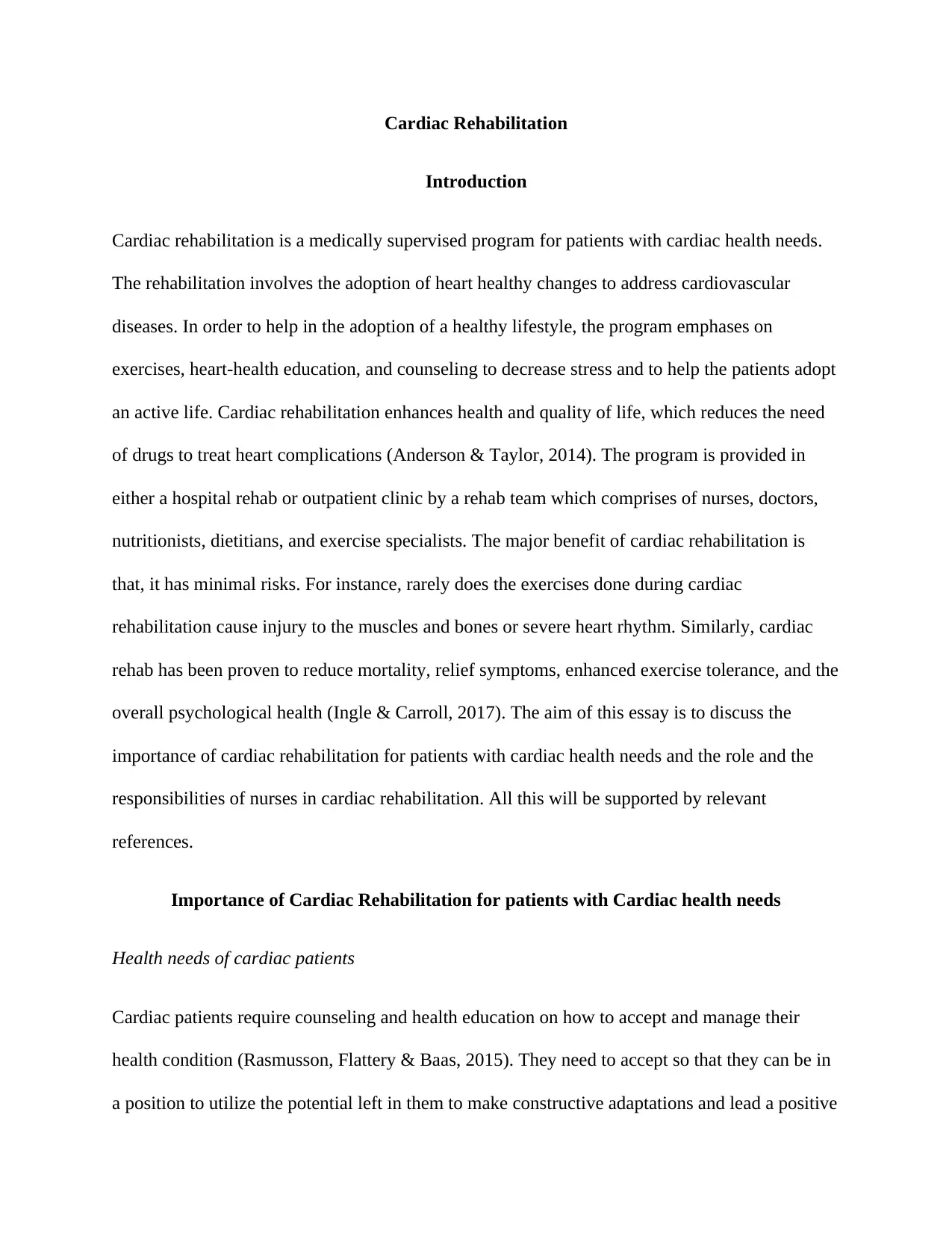
Cardiac Rehabilitation
Introduction
Cardiac rehabilitation is a medically supervised program for patients with cardiac health needs.
The rehabilitation involves the adoption of heart healthy changes to address cardiovascular
diseases. In order to help in the adoption of a healthy lifestyle, the program emphases on
exercises, heart-health education, and counseling to decrease stress and to help the patients adopt
an active life. Cardiac rehabilitation enhances health and quality of life, which reduces the need
of drugs to treat heart complications (Anderson & Taylor, 2014). The program is provided in
either a hospital rehab or outpatient clinic by a rehab team which comprises of nurses, doctors,
nutritionists, dietitians, and exercise specialists. The major benefit of cardiac rehabilitation is
that, it has minimal risks. For instance, rarely does the exercises done during cardiac
rehabilitation cause injury to the muscles and bones or severe heart rhythm. Similarly, cardiac
rehab has been proven to reduce mortality, relief symptoms, enhanced exercise tolerance, and the
overall psychological health (Ingle & Carroll, 2017). The aim of this essay is to discuss the
importance of cardiac rehabilitation for patients with cardiac health needs and the role and the
responsibilities of nurses in cardiac rehabilitation. All this will be supported by relevant
references.
Importance of Cardiac Rehabilitation for patients with Cardiac health needs
Health needs of cardiac patients
Cardiac patients require counseling and health education on how to accept and manage their
health condition (Rasmusson, Flattery & Baas, 2015). They need to accept so that they can be in
a position to utilize the potential left in them to make constructive adaptations and lead a positive
Introduction
Cardiac rehabilitation is a medically supervised program for patients with cardiac health needs.
The rehabilitation involves the adoption of heart healthy changes to address cardiovascular
diseases. In order to help in the adoption of a healthy lifestyle, the program emphases on
exercises, heart-health education, and counseling to decrease stress and to help the patients adopt
an active life. Cardiac rehabilitation enhances health and quality of life, which reduces the need
of drugs to treat heart complications (Anderson & Taylor, 2014). The program is provided in
either a hospital rehab or outpatient clinic by a rehab team which comprises of nurses, doctors,
nutritionists, dietitians, and exercise specialists. The major benefit of cardiac rehabilitation is
that, it has minimal risks. For instance, rarely does the exercises done during cardiac
rehabilitation cause injury to the muscles and bones or severe heart rhythm. Similarly, cardiac
rehab has been proven to reduce mortality, relief symptoms, enhanced exercise tolerance, and the
overall psychological health (Ingle & Carroll, 2017). The aim of this essay is to discuss the
importance of cardiac rehabilitation for patients with cardiac health needs and the role and the
responsibilities of nurses in cardiac rehabilitation. All this will be supported by relevant
references.
Importance of Cardiac Rehabilitation for patients with Cardiac health needs
Health needs of cardiac patients
Cardiac patients require counseling and health education on how to accept and manage their
health condition (Rasmusson, Flattery & Baas, 2015). They need to accept so that they can be in
a position to utilize the potential left in them to make constructive adaptations and lead a positive
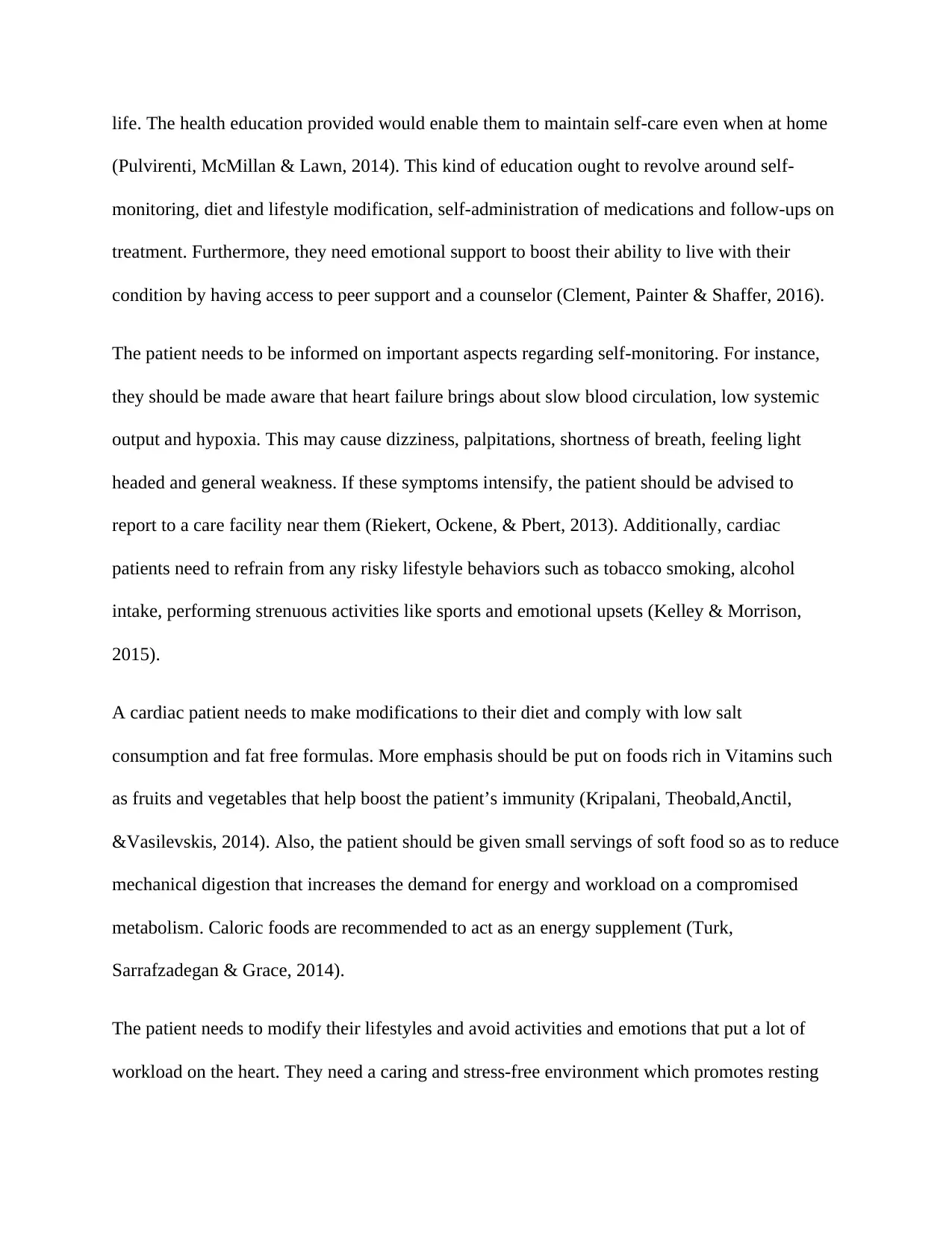
life. The health education provided would enable them to maintain self-care even when at home
(Pulvirenti, McMillan & Lawn, 2014). This kind of education ought to revolve around self-
monitoring, diet and lifestyle modification, self-administration of medications and follow-ups on
treatment. Furthermore, they need emotional support to boost their ability to live with their
condition by having access to peer support and a counselor (Clement, Painter & Shaffer, 2016).
The patient needs to be informed on important aspects regarding self-monitoring. For instance,
they should be made aware that heart failure brings about slow blood circulation, low systemic
output and hypoxia. This may cause dizziness, palpitations, shortness of breath, feeling light
headed and general weakness. If these symptoms intensify, the patient should be advised to
report to a care facility near them (Riekert, Ockene, & Pbert, 2013). Additionally, cardiac
patients need to refrain from any risky lifestyle behaviors such as tobacco smoking, alcohol
intake, performing strenuous activities like sports and emotional upsets (Kelley & Morrison,
2015).
A cardiac patient needs to make modifications to their diet and comply with low salt
consumption and fat free formulas. More emphasis should be put on foods rich in Vitamins such
as fruits and vegetables that help boost the patient’s immunity (Kripalani, Theobald,Anctil,
&Vasilevskis, 2014). Also, the patient should be given small servings of soft food so as to reduce
mechanical digestion that increases the demand for energy and workload on a compromised
metabolism. Caloric foods are recommended to act as an energy supplement (Turk,
Sarrafzadegan & Grace, 2014).
The patient needs to modify their lifestyles and avoid activities and emotions that put a lot of
workload on the heart. They need a caring and stress-free environment which promotes resting
(Pulvirenti, McMillan & Lawn, 2014). This kind of education ought to revolve around self-
monitoring, diet and lifestyle modification, self-administration of medications and follow-ups on
treatment. Furthermore, they need emotional support to boost their ability to live with their
condition by having access to peer support and a counselor (Clement, Painter & Shaffer, 2016).
The patient needs to be informed on important aspects regarding self-monitoring. For instance,
they should be made aware that heart failure brings about slow blood circulation, low systemic
output and hypoxia. This may cause dizziness, palpitations, shortness of breath, feeling light
headed and general weakness. If these symptoms intensify, the patient should be advised to
report to a care facility near them (Riekert, Ockene, & Pbert, 2013). Additionally, cardiac
patients need to refrain from any risky lifestyle behaviors such as tobacco smoking, alcohol
intake, performing strenuous activities like sports and emotional upsets (Kelley & Morrison,
2015).
A cardiac patient needs to make modifications to their diet and comply with low salt
consumption and fat free formulas. More emphasis should be put on foods rich in Vitamins such
as fruits and vegetables that help boost the patient’s immunity (Kripalani, Theobald,Anctil,
&Vasilevskis, 2014). Also, the patient should be given small servings of soft food so as to reduce
mechanical digestion that increases the demand for energy and workload on a compromised
metabolism. Caloric foods are recommended to act as an energy supplement (Turk,
Sarrafzadegan & Grace, 2014).
The patient needs to modify their lifestyles and avoid activities and emotions that put a lot of
workload on the heart. They need a caring and stress-free environment which promotes resting
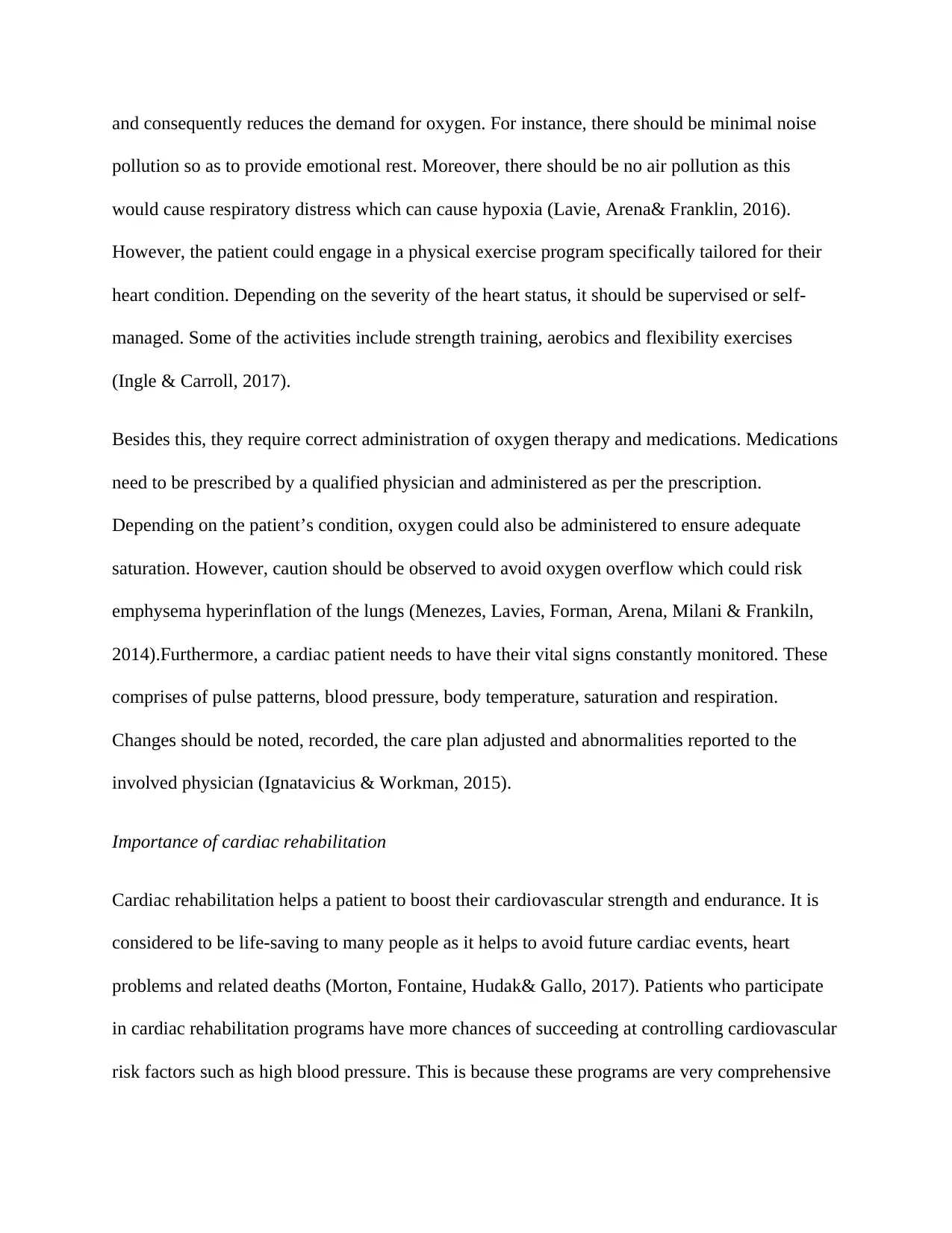
and consequently reduces the demand for oxygen. For instance, there should be minimal noise
pollution so as to provide emotional rest. Moreover, there should be no air pollution as this
would cause respiratory distress which can cause hypoxia (Lavie, Arena& Franklin, 2016).
However, the patient could engage in a physical exercise program specifically tailored for their
heart condition. Depending on the severity of the heart status, it should be supervised or self-
managed. Some of the activities include strength training, aerobics and flexibility exercises
(Ingle & Carroll, 2017).
Besides this, they require correct administration of oxygen therapy and medications. Medications
need to be prescribed by a qualified physician and administered as per the prescription.
Depending on the patient’s condition, oxygen could also be administered to ensure adequate
saturation. However, caution should be observed to avoid oxygen overflow which could risk
emphysema hyperinflation of the lungs (Menezes, Lavies, Forman, Arena, Milani & Frankiln,
2014).Furthermore, a cardiac patient needs to have their vital signs constantly monitored. These
comprises of pulse patterns, blood pressure, body temperature, saturation and respiration.
Changes should be noted, recorded, the care plan adjusted and abnormalities reported to the
involved physician (Ignatavicius & Workman, 2015).
Importance of cardiac rehabilitation
Cardiac rehabilitation helps a patient to boost their cardiovascular strength and endurance. It is
considered to be life-saving to many people as it helps to avoid future cardiac events, heart
problems and related deaths (Morton, Fontaine, Hudak& Gallo, 2017). Patients who participate
in cardiac rehabilitation programs have more chances of succeeding at controlling cardiovascular
risk factors such as high blood pressure. This is because these programs are very comprehensive
pollution so as to provide emotional rest. Moreover, there should be no air pollution as this
would cause respiratory distress which can cause hypoxia (Lavie, Arena& Franklin, 2016).
However, the patient could engage in a physical exercise program specifically tailored for their
heart condition. Depending on the severity of the heart status, it should be supervised or self-
managed. Some of the activities include strength training, aerobics and flexibility exercises
(Ingle & Carroll, 2017).
Besides this, they require correct administration of oxygen therapy and medications. Medications
need to be prescribed by a qualified physician and administered as per the prescription.
Depending on the patient’s condition, oxygen could also be administered to ensure adequate
saturation. However, caution should be observed to avoid oxygen overflow which could risk
emphysema hyperinflation of the lungs (Menezes, Lavies, Forman, Arena, Milani & Frankiln,
2014).Furthermore, a cardiac patient needs to have their vital signs constantly monitored. These
comprises of pulse patterns, blood pressure, body temperature, saturation and respiration.
Changes should be noted, recorded, the care plan adjusted and abnormalities reported to the
involved physician (Ignatavicius & Workman, 2015).
Importance of cardiac rehabilitation
Cardiac rehabilitation helps a patient to boost their cardiovascular strength and endurance. It is
considered to be life-saving to many people as it helps to avoid future cardiac events, heart
problems and related deaths (Morton, Fontaine, Hudak& Gallo, 2017). Patients who participate
in cardiac rehabilitation programs have more chances of succeeding at controlling cardiovascular
risk factors such as high blood pressure. This is because these programs are very comprehensive
Secure Best Marks with AI Grader
Need help grading? Try our AI Grader for instant feedback on your assignments.
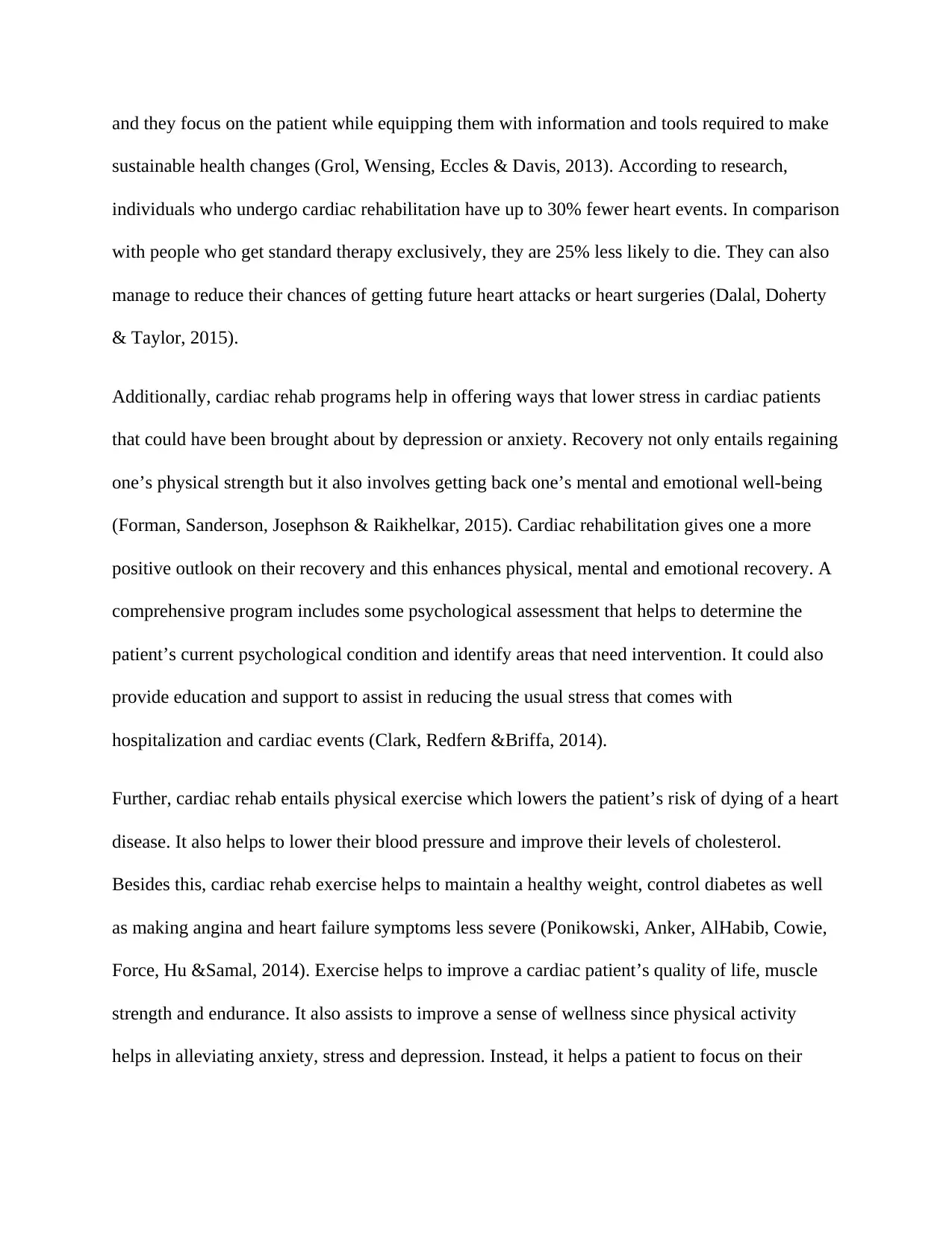
and they focus on the patient while equipping them with information and tools required to make
sustainable health changes (Grol, Wensing, Eccles & Davis, 2013). According to research,
individuals who undergo cardiac rehabilitation have up to 30% fewer heart events. In comparison
with people who get standard therapy exclusively, they are 25% less likely to die. They can also
manage to reduce their chances of getting future heart attacks or heart surgeries (Dalal, Doherty
& Taylor, 2015).
Additionally, cardiac rehab programs help in offering ways that lower stress in cardiac patients
that could have been brought about by depression or anxiety. Recovery not only entails regaining
one’s physical strength but it also involves getting back one’s mental and emotional well-being
(Forman, Sanderson, Josephson & Raikhelkar, 2015). Cardiac rehabilitation gives one a more
positive outlook on their recovery and this enhances physical, mental and emotional recovery. A
comprehensive program includes some psychological assessment that helps to determine the
patient’s current psychological condition and identify areas that need intervention. It could also
provide education and support to assist in reducing the usual stress that comes with
hospitalization and cardiac events (Clark, Redfern &Briffa, 2014).
Further, cardiac rehab entails physical exercise which lowers the patient’s risk of dying of a heart
disease. It also helps to lower their blood pressure and improve their levels of cholesterol.
Besides this, cardiac rehab exercise helps to maintain a healthy weight, control diabetes as well
as making angina and heart failure symptoms less severe (Ponikowski, Anker, AlHabib, Cowie,
Force, Hu &Samal, 2014). Exercise helps to improve a cardiac patient’s quality of life, muscle
strength and endurance. It also assists to improve a sense of wellness since physical activity
helps in alleviating anxiety, stress and depression. Instead, it helps a patient to focus on their
sustainable health changes (Grol, Wensing, Eccles & Davis, 2013). According to research,
individuals who undergo cardiac rehabilitation have up to 30% fewer heart events. In comparison
with people who get standard therapy exclusively, they are 25% less likely to die. They can also
manage to reduce their chances of getting future heart attacks or heart surgeries (Dalal, Doherty
& Taylor, 2015).
Additionally, cardiac rehab programs help in offering ways that lower stress in cardiac patients
that could have been brought about by depression or anxiety. Recovery not only entails regaining
one’s physical strength but it also involves getting back one’s mental and emotional well-being
(Forman, Sanderson, Josephson & Raikhelkar, 2015). Cardiac rehabilitation gives one a more
positive outlook on their recovery and this enhances physical, mental and emotional recovery. A
comprehensive program includes some psychological assessment that helps to determine the
patient’s current psychological condition and identify areas that need intervention. It could also
provide education and support to assist in reducing the usual stress that comes with
hospitalization and cardiac events (Clark, Redfern &Briffa, 2014).
Further, cardiac rehab entails physical exercise which lowers the patient’s risk of dying of a heart
disease. It also helps to lower their blood pressure and improve their levels of cholesterol.
Besides this, cardiac rehab exercise helps to maintain a healthy weight, control diabetes as well
as making angina and heart failure symptoms less severe (Ponikowski, Anker, AlHabib, Cowie,
Force, Hu &Samal, 2014). Exercise helps to improve a cardiac patient’s quality of life, muscle
strength and endurance. It also assists to improve a sense of wellness since physical activity
helps in alleviating anxiety, stress and depression. Instead, it helps a patient to focus on their
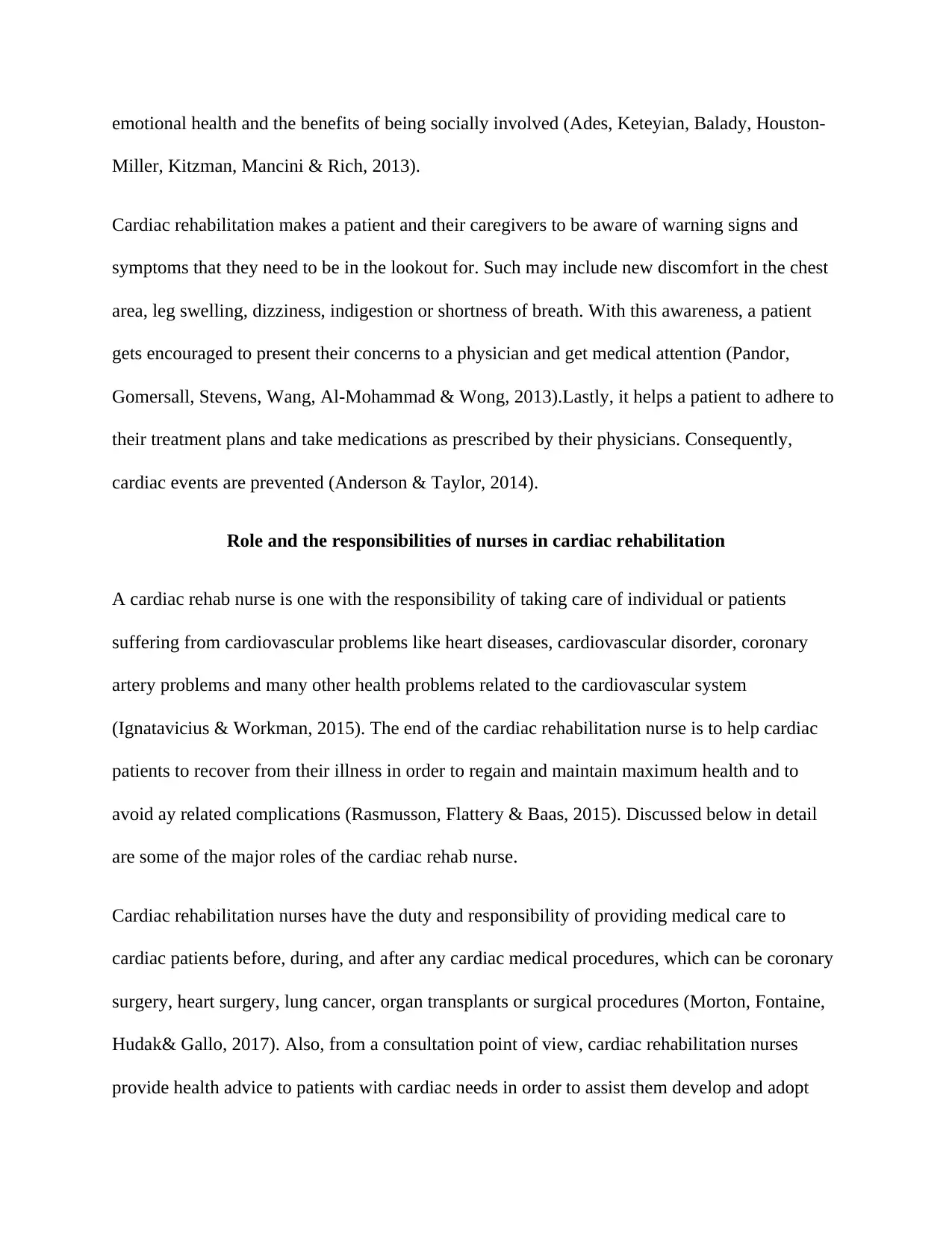
emotional health and the benefits of being socially involved (Ades, Keteyian, Balady, Houston-
Miller, Kitzman, Mancini & Rich, 2013).
Cardiac rehabilitation makes a patient and their caregivers to be aware of warning signs and
symptoms that they need to be in the lookout for. Such may include new discomfort in the chest
area, leg swelling, dizziness, indigestion or shortness of breath. With this awareness, a patient
gets encouraged to present their concerns to a physician and get medical attention (Pandor,
Gomersall, Stevens, Wang, Al-Mohammad & Wong, 2013).Lastly, it helps a patient to adhere to
their treatment plans and take medications as prescribed by their physicians. Consequently,
cardiac events are prevented (Anderson & Taylor, 2014).
Role and the responsibilities of nurses in cardiac rehabilitation
A cardiac rehab nurse is one with the responsibility of taking care of individual or patients
suffering from cardiovascular problems like heart diseases, cardiovascular disorder, coronary
artery problems and many other health problems related to the cardiovascular system
(Ignatavicius & Workman, 2015). The end of the cardiac rehabilitation nurse is to help cardiac
patients to recover from their illness in order to regain and maintain maximum health and to
avoid ay related complications (Rasmusson, Flattery & Baas, 2015). Discussed below in detail
are some of the major roles of the cardiac rehab nurse.
Cardiac rehabilitation nurses have the duty and responsibility of providing medical care to
cardiac patients before, during, and after any cardiac medical procedures, which can be coronary
surgery, heart surgery, lung cancer, organ transplants or surgical procedures (Morton, Fontaine,
Hudak& Gallo, 2017). Also, from a consultation point of view, cardiac rehabilitation nurses
provide health advice to patients with cardiac needs in order to assist them develop and adopt
Miller, Kitzman, Mancini & Rich, 2013).
Cardiac rehabilitation makes a patient and their caregivers to be aware of warning signs and
symptoms that they need to be in the lookout for. Such may include new discomfort in the chest
area, leg swelling, dizziness, indigestion or shortness of breath. With this awareness, a patient
gets encouraged to present their concerns to a physician and get medical attention (Pandor,
Gomersall, Stevens, Wang, Al-Mohammad & Wong, 2013).Lastly, it helps a patient to adhere to
their treatment plans and take medications as prescribed by their physicians. Consequently,
cardiac events are prevented (Anderson & Taylor, 2014).
Role and the responsibilities of nurses in cardiac rehabilitation
A cardiac rehab nurse is one with the responsibility of taking care of individual or patients
suffering from cardiovascular problems like heart diseases, cardiovascular disorder, coronary
artery problems and many other health problems related to the cardiovascular system
(Ignatavicius & Workman, 2015). The end of the cardiac rehabilitation nurse is to help cardiac
patients to recover from their illness in order to regain and maintain maximum health and to
avoid ay related complications (Rasmusson, Flattery & Baas, 2015). Discussed below in detail
are some of the major roles of the cardiac rehab nurse.
Cardiac rehabilitation nurses have the duty and responsibility of providing medical care to
cardiac patients before, during, and after any cardiac medical procedures, which can be coronary
surgery, heart surgery, lung cancer, organ transplants or surgical procedures (Morton, Fontaine,
Hudak& Gallo, 2017). Also, from a consultation point of view, cardiac rehabilitation nurses
provide health advice to patients with cardiac needs in order to assist them develop and adopt
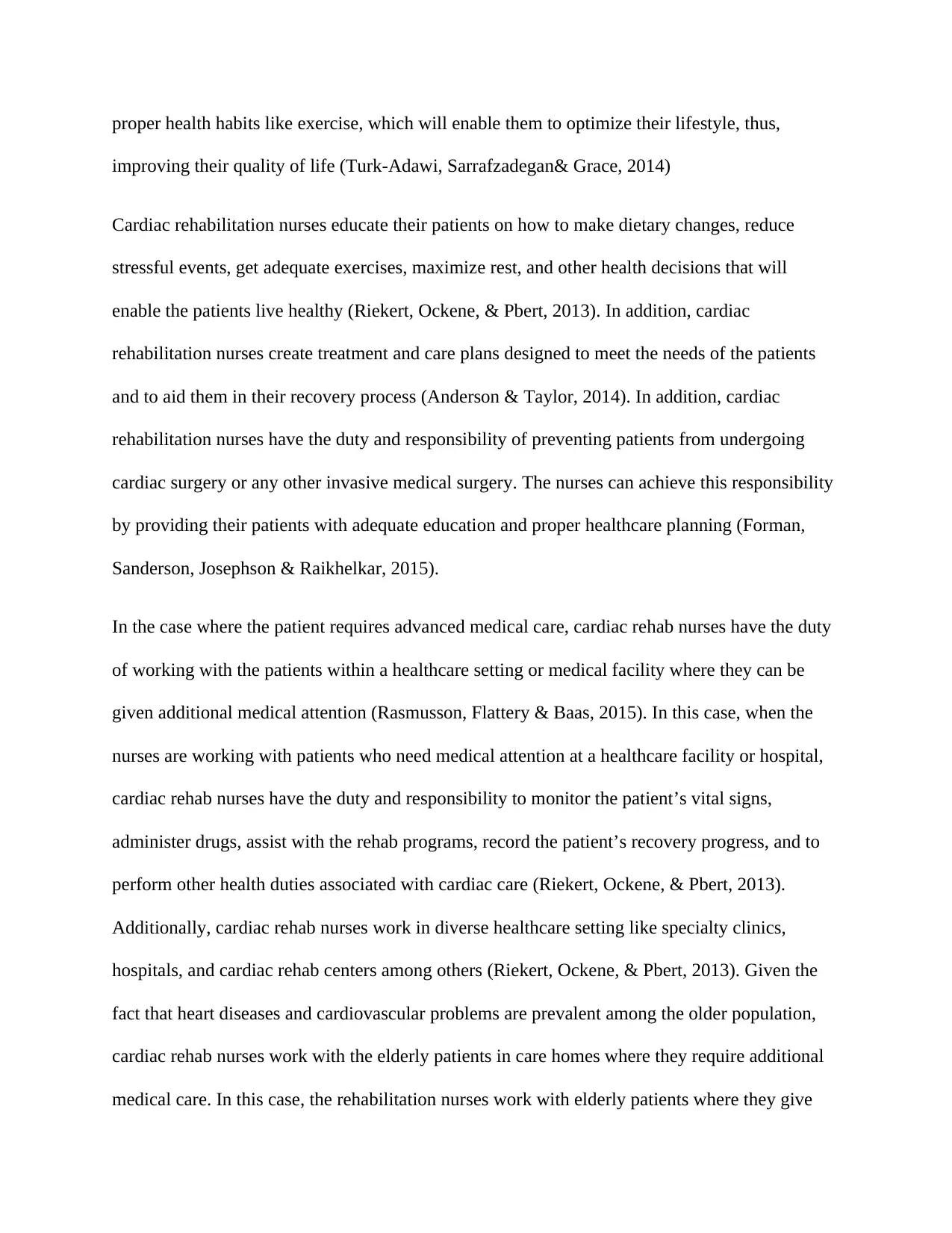
proper health habits like exercise, which will enable them to optimize their lifestyle, thus,
improving their quality of life (Turk-Adawi, Sarrafzadegan& Grace, 2014)
Cardiac rehabilitation nurses educate their patients on how to make dietary changes, reduce
stressful events, get adequate exercises, maximize rest, and other health decisions that will
enable the patients live healthy (Riekert, Ockene, & Pbert, 2013). In addition, cardiac
rehabilitation nurses create treatment and care plans designed to meet the needs of the patients
and to aid them in their recovery process (Anderson & Taylor, 2014). In addition, cardiac
rehabilitation nurses have the duty and responsibility of preventing patients from undergoing
cardiac surgery or any other invasive medical surgery. The nurses can achieve this responsibility
by providing their patients with adequate education and proper healthcare planning (Forman,
Sanderson, Josephson & Raikhelkar, 2015).
In the case where the patient requires advanced medical care, cardiac rehab nurses have the duty
of working with the patients within a healthcare setting or medical facility where they can be
given additional medical attention (Rasmusson, Flattery & Baas, 2015). In this case, when the
nurses are working with patients who need medical attention at a healthcare facility or hospital,
cardiac rehab nurses have the duty and responsibility to monitor the patient’s vital signs,
administer drugs, assist with the rehab programs, record the patient’s recovery progress, and to
perform other health duties associated with cardiac care (Riekert, Ockene, & Pbert, 2013).
Additionally, cardiac rehab nurses work in diverse healthcare setting like specialty clinics,
hospitals, and cardiac rehab centers among others (Riekert, Ockene, & Pbert, 2013). Given the
fact that heart diseases and cardiovascular problems are prevalent among the older population,
cardiac rehab nurses work with the elderly patients in care homes where they require additional
medical care. In this case, the rehabilitation nurses work with elderly patients where they give
improving their quality of life (Turk-Adawi, Sarrafzadegan& Grace, 2014)
Cardiac rehabilitation nurses educate their patients on how to make dietary changes, reduce
stressful events, get adequate exercises, maximize rest, and other health decisions that will
enable the patients live healthy (Riekert, Ockene, & Pbert, 2013). In addition, cardiac
rehabilitation nurses create treatment and care plans designed to meet the needs of the patients
and to aid them in their recovery process (Anderson & Taylor, 2014). In addition, cardiac
rehabilitation nurses have the duty and responsibility of preventing patients from undergoing
cardiac surgery or any other invasive medical surgery. The nurses can achieve this responsibility
by providing their patients with adequate education and proper healthcare planning (Forman,
Sanderson, Josephson & Raikhelkar, 2015).
In the case where the patient requires advanced medical care, cardiac rehab nurses have the duty
of working with the patients within a healthcare setting or medical facility where they can be
given additional medical attention (Rasmusson, Flattery & Baas, 2015). In this case, when the
nurses are working with patients who need medical attention at a healthcare facility or hospital,
cardiac rehab nurses have the duty and responsibility to monitor the patient’s vital signs,
administer drugs, assist with the rehab programs, record the patient’s recovery progress, and to
perform other health duties associated with cardiac care (Riekert, Ockene, & Pbert, 2013).
Additionally, cardiac rehab nurses work in diverse healthcare setting like specialty clinics,
hospitals, and cardiac rehab centers among others (Riekert, Ockene, & Pbert, 2013). Given the
fact that heart diseases and cardiovascular problems are prevalent among the older population,
cardiac rehab nurses work with the elderly patients in care homes where they require additional
medical care. In this case, the rehabilitation nurses work with elderly patients where they give
Paraphrase This Document
Need a fresh take? Get an instant paraphrase of this document with our AI Paraphraser
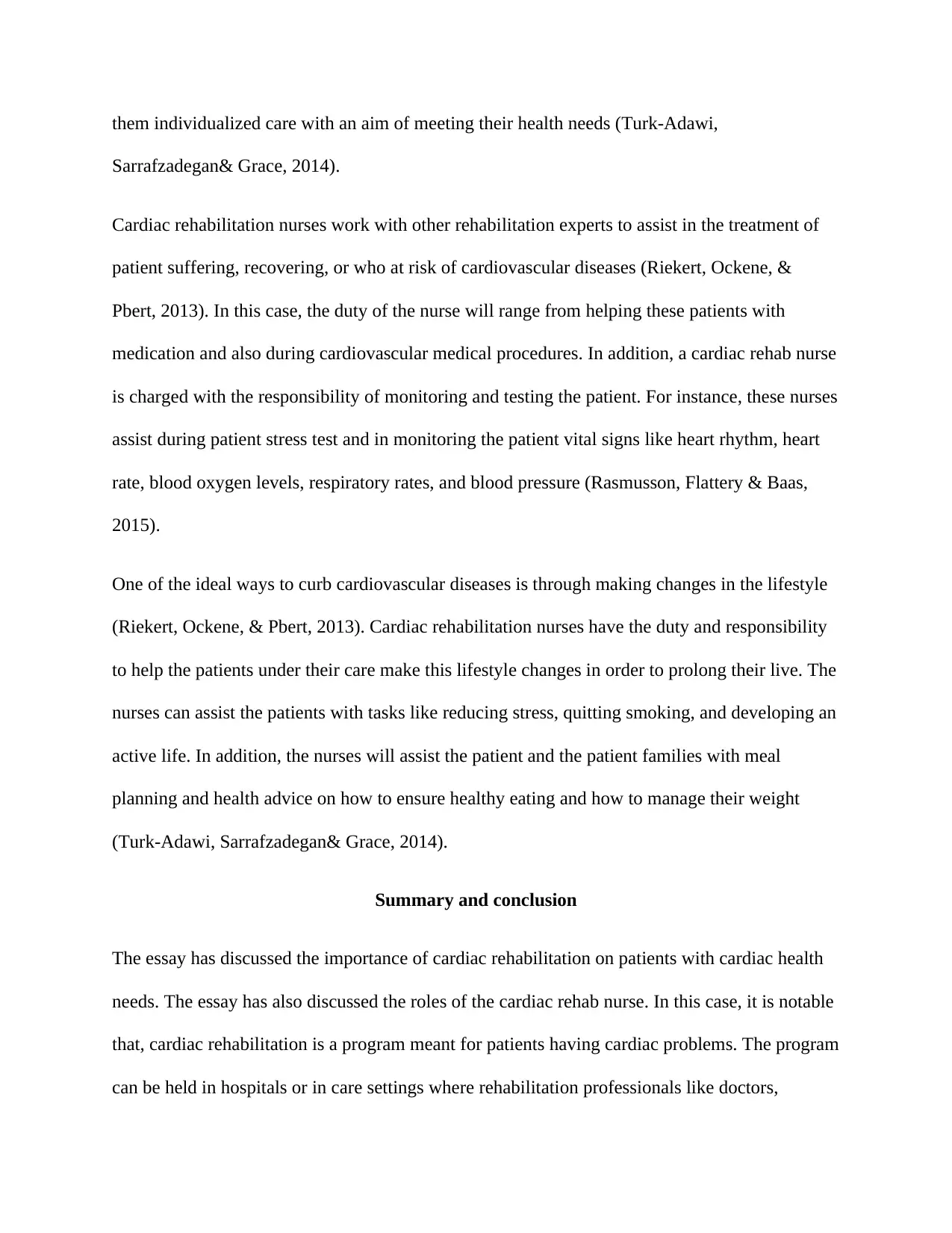
them individualized care with an aim of meeting their health needs (Turk-Adawi,
Sarrafzadegan& Grace, 2014).
Cardiac rehabilitation nurses work with other rehabilitation experts to assist in the treatment of
patient suffering, recovering, or who at risk of cardiovascular diseases (Riekert, Ockene, &
Pbert, 2013). In this case, the duty of the nurse will range from helping these patients with
medication and also during cardiovascular medical procedures. In addition, a cardiac rehab nurse
is charged with the responsibility of monitoring and testing the patient. For instance, these nurses
assist during patient stress test and in monitoring the patient vital signs like heart rhythm, heart
rate, blood oxygen levels, respiratory rates, and blood pressure (Rasmusson, Flattery & Baas,
2015).
One of the ideal ways to curb cardiovascular diseases is through making changes in the lifestyle
(Riekert, Ockene, & Pbert, 2013). Cardiac rehabilitation nurses have the duty and responsibility
to help the patients under their care make this lifestyle changes in order to prolong their live. The
nurses can assist the patients with tasks like reducing stress, quitting smoking, and developing an
active life. In addition, the nurses will assist the patient and the patient families with meal
planning and health advice on how to ensure healthy eating and how to manage their weight
(Turk-Adawi, Sarrafzadegan& Grace, 2014).
Summary and conclusion
The essay has discussed the importance of cardiac rehabilitation on patients with cardiac health
needs. The essay has also discussed the roles of the cardiac rehab nurse. In this case, it is notable
that, cardiac rehabilitation is a program meant for patients having cardiac problems. The program
can be held in hospitals or in care settings where rehabilitation professionals like doctors,
Sarrafzadegan& Grace, 2014).
Cardiac rehabilitation nurses work with other rehabilitation experts to assist in the treatment of
patient suffering, recovering, or who at risk of cardiovascular diseases (Riekert, Ockene, &
Pbert, 2013). In this case, the duty of the nurse will range from helping these patients with
medication and also during cardiovascular medical procedures. In addition, a cardiac rehab nurse
is charged with the responsibility of monitoring and testing the patient. For instance, these nurses
assist during patient stress test and in monitoring the patient vital signs like heart rhythm, heart
rate, blood oxygen levels, respiratory rates, and blood pressure (Rasmusson, Flattery & Baas,
2015).
One of the ideal ways to curb cardiovascular diseases is through making changes in the lifestyle
(Riekert, Ockene, & Pbert, 2013). Cardiac rehabilitation nurses have the duty and responsibility
to help the patients under their care make this lifestyle changes in order to prolong their live. The
nurses can assist the patients with tasks like reducing stress, quitting smoking, and developing an
active life. In addition, the nurses will assist the patient and the patient families with meal
planning and health advice on how to ensure healthy eating and how to manage their weight
(Turk-Adawi, Sarrafzadegan& Grace, 2014).
Summary and conclusion
The essay has discussed the importance of cardiac rehabilitation on patients with cardiac health
needs. The essay has also discussed the roles of the cardiac rehab nurse. In this case, it is notable
that, cardiac rehabilitation is a program meant for patients having cardiac problems. The program
can be held in hospitals or in care settings where rehabilitation professionals like doctors,
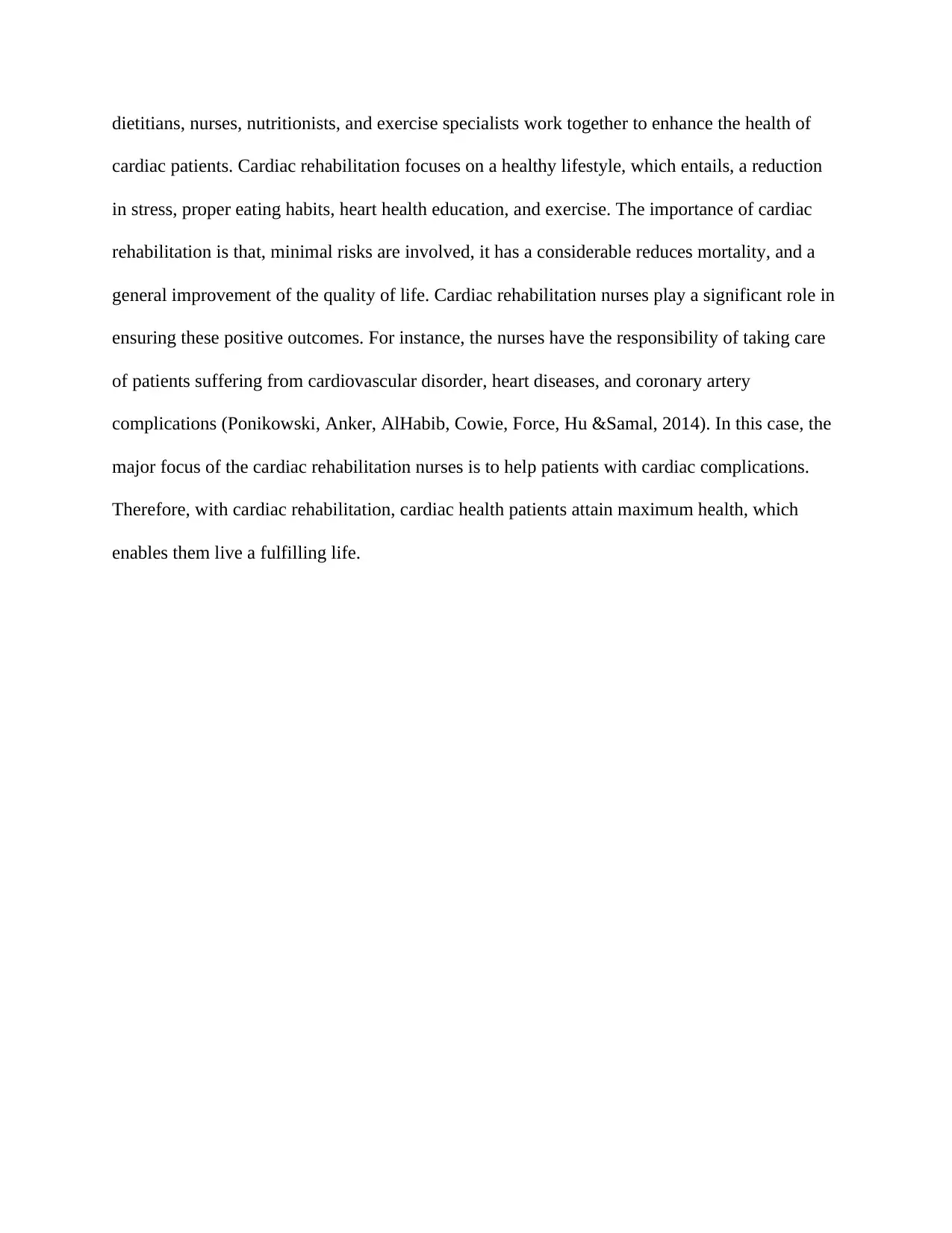
dietitians, nurses, nutritionists, and exercise specialists work together to enhance the health of
cardiac patients. Cardiac rehabilitation focuses on a healthy lifestyle, which entails, a reduction
in stress, proper eating habits, heart health education, and exercise. The importance of cardiac
rehabilitation is that, minimal risks are involved, it has a considerable reduces mortality, and a
general improvement of the quality of life. Cardiac rehabilitation nurses play a significant role in
ensuring these positive outcomes. For instance, the nurses have the responsibility of taking care
of patients suffering from cardiovascular disorder, heart diseases, and coronary artery
complications (Ponikowski, Anker, AlHabib, Cowie, Force, Hu &Samal, 2014). In this case, the
major focus of the cardiac rehabilitation nurses is to help patients with cardiac complications.
Therefore, with cardiac rehabilitation, cardiac health patients attain maximum health, which
enables them live a fulfilling life.
cardiac patients. Cardiac rehabilitation focuses on a healthy lifestyle, which entails, a reduction
in stress, proper eating habits, heart health education, and exercise. The importance of cardiac
rehabilitation is that, minimal risks are involved, it has a considerable reduces mortality, and a
general improvement of the quality of life. Cardiac rehabilitation nurses play a significant role in
ensuring these positive outcomes. For instance, the nurses have the responsibility of taking care
of patients suffering from cardiovascular disorder, heart diseases, and coronary artery
complications (Ponikowski, Anker, AlHabib, Cowie, Force, Hu &Samal, 2014). In this case, the
major focus of the cardiac rehabilitation nurses is to help patients with cardiac complications.
Therefore, with cardiac rehabilitation, cardiac health patients attain maximum health, which
enables them live a fulfilling life.
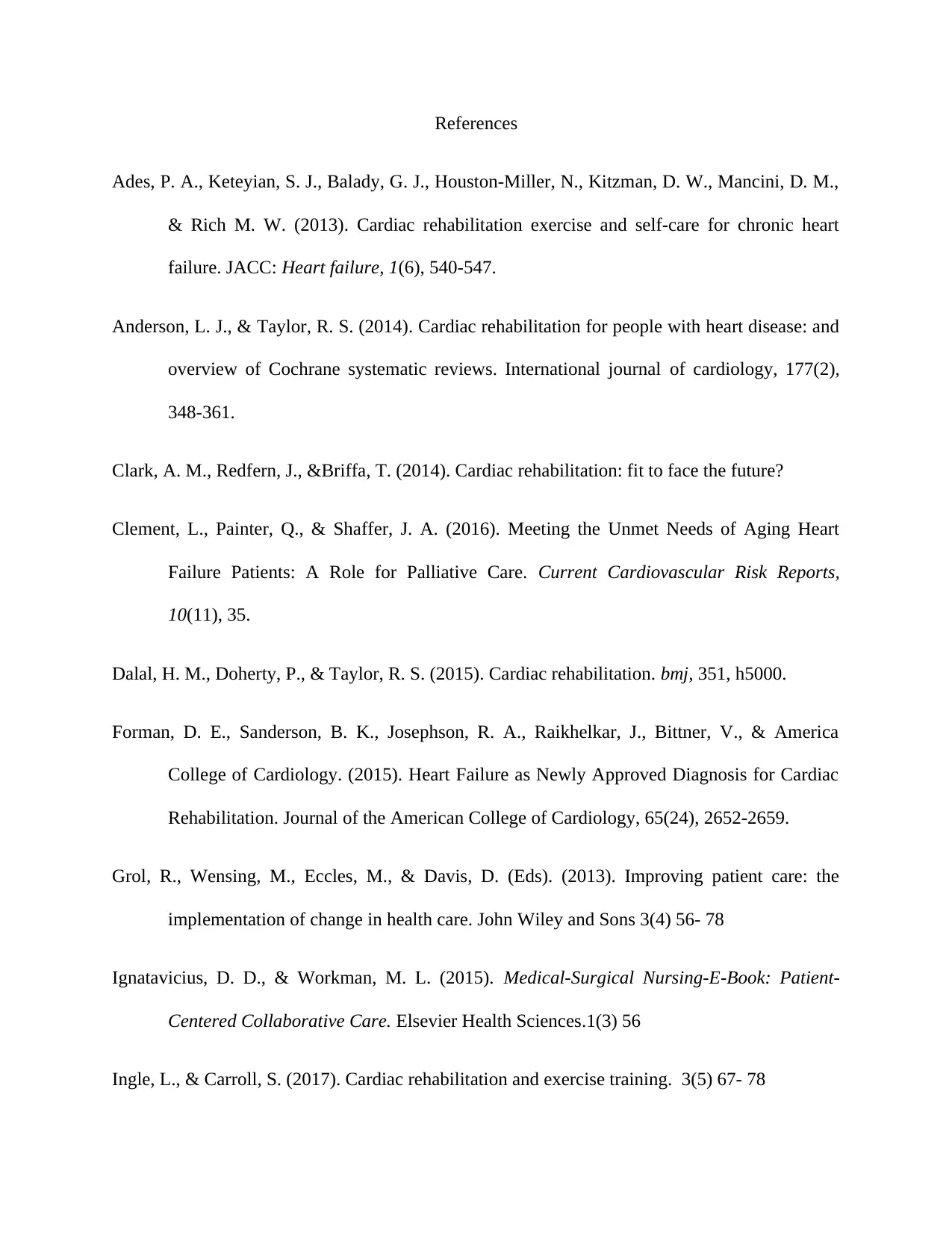
References
Ades, P. A., Keteyian, S. J., Balady, G. J., Houston-Miller, N., Kitzman, D. W., Mancini, D. M.,
& Rich M. W. (2013). Cardiac rehabilitation exercise and self-care for chronic heart
failure. JACC: Heart failure, 1(6), 540-547.
Anderson, L. J., & Taylor, R. S. (2014). Cardiac rehabilitation for people with heart disease: and
overview of Cochrane systematic reviews. International journal of cardiology, 177(2),
348-361.
Clark, A. M., Redfern, J., &Briffa, T. (2014). Cardiac rehabilitation: fit to face the future?
Clement, L., Painter, Q., & Shaffer, J. A. (2016). Meeting the Unmet Needs of Aging Heart
Failure Patients: A Role for Palliative Care. Current Cardiovascular Risk Reports,
10(11), 35.
Dalal, H. M., Doherty, P., & Taylor, R. S. (2015). Cardiac rehabilitation. bmj, 351, h5000.
Forman, D. E., Sanderson, B. K., Josephson, R. A., Raikhelkar, J., Bittner, V., & America
College of Cardiology. (2015). Heart Failure as Newly Approved Diagnosis for Cardiac
Rehabilitation. Journal of the American College of Cardiology, 65(24), 2652-2659.
Grol, R., Wensing, M., Eccles, M., & Davis, D. (Eds). (2013). Improving patient care: the
implementation of change in health care. John Wiley and Sons 3(4) 56- 78
Ignatavicius, D. D., & Workman, M. L. (2015). Medical-Surgical Nursing-E-Book: Patient-
Centered Collaborative Care. Elsevier Health Sciences.1(3) 56
Ingle, L., & Carroll, S. (2017). Cardiac rehabilitation and exercise training. 3(5) 67- 78
Ades, P. A., Keteyian, S. J., Balady, G. J., Houston-Miller, N., Kitzman, D. W., Mancini, D. M.,
& Rich M. W. (2013). Cardiac rehabilitation exercise and self-care for chronic heart
failure. JACC: Heart failure, 1(6), 540-547.
Anderson, L. J., & Taylor, R. S. (2014). Cardiac rehabilitation for people with heart disease: and
overview of Cochrane systematic reviews. International journal of cardiology, 177(2),
348-361.
Clark, A. M., Redfern, J., &Briffa, T. (2014). Cardiac rehabilitation: fit to face the future?
Clement, L., Painter, Q., & Shaffer, J. A. (2016). Meeting the Unmet Needs of Aging Heart
Failure Patients: A Role for Palliative Care. Current Cardiovascular Risk Reports,
10(11), 35.
Dalal, H. M., Doherty, P., & Taylor, R. S. (2015). Cardiac rehabilitation. bmj, 351, h5000.
Forman, D. E., Sanderson, B. K., Josephson, R. A., Raikhelkar, J., Bittner, V., & America
College of Cardiology. (2015). Heart Failure as Newly Approved Diagnosis for Cardiac
Rehabilitation. Journal of the American College of Cardiology, 65(24), 2652-2659.
Grol, R., Wensing, M., Eccles, M., & Davis, D. (Eds). (2013). Improving patient care: the
implementation of change in health care. John Wiley and Sons 3(4) 56- 78
Ignatavicius, D. D., & Workman, M. L. (2015). Medical-Surgical Nursing-E-Book: Patient-
Centered Collaborative Care. Elsevier Health Sciences.1(3) 56
Ingle, L., & Carroll, S. (2017). Cardiac rehabilitation and exercise training. 3(5) 67- 78
Secure Best Marks with AI Grader
Need help grading? Try our AI Grader for instant feedback on your assignments.
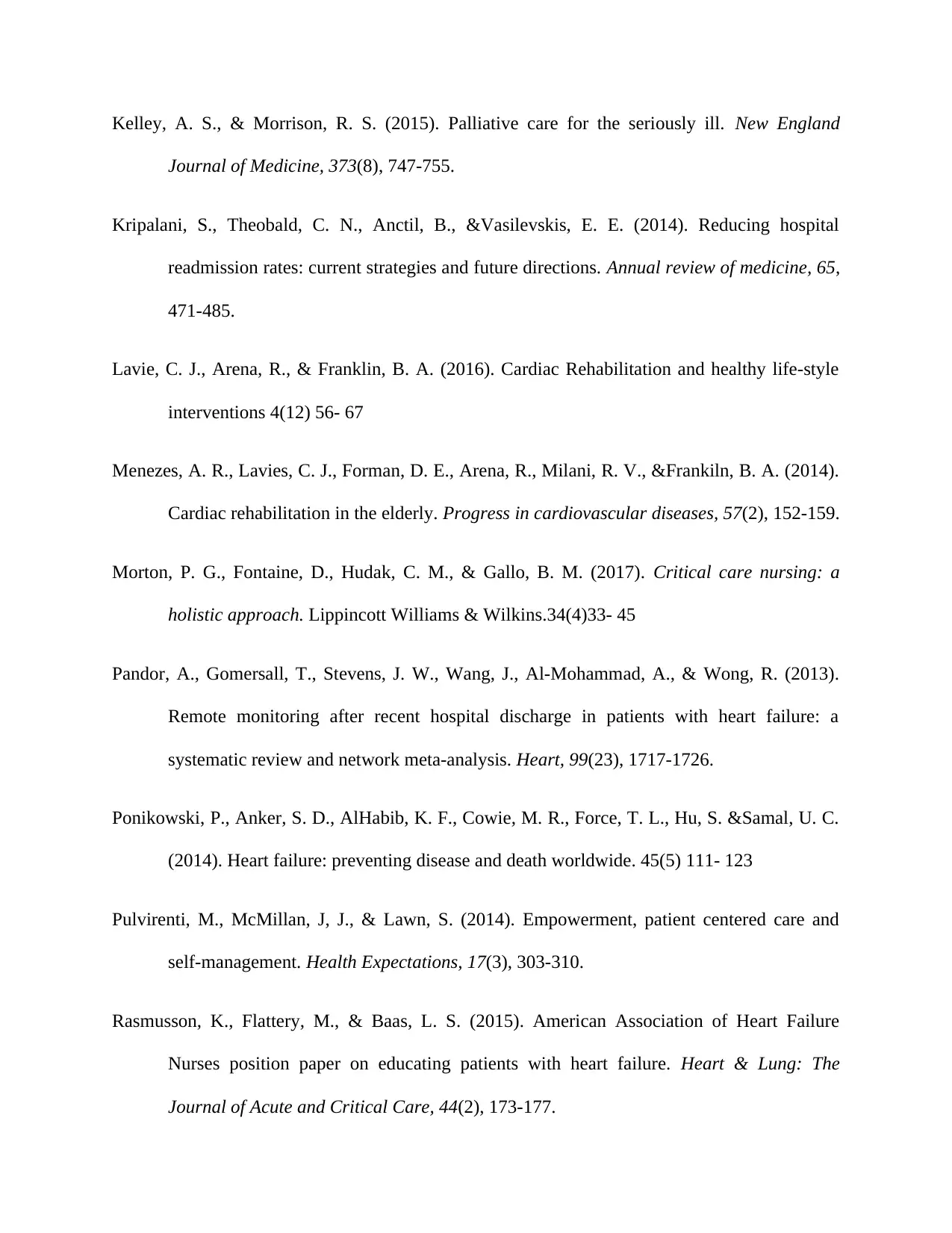
Kelley, A. S., & Morrison, R. S. (2015). Palliative care for the seriously ill. New England
Journal of Medicine, 373(8), 747-755.
Kripalani, S., Theobald, C. N., Anctil, B., &Vasilevskis, E. E. (2014). Reducing hospital
readmission rates: current strategies and future directions. Annual review of medicine, 65,
471-485.
Lavie, C. J., Arena, R., & Franklin, B. A. (2016). Cardiac Rehabilitation and healthy life-style
interventions 4(12) 56- 67
Menezes, A. R., Lavies, C. J., Forman, D. E., Arena, R., Milani, R. V., &Frankiln, B. A. (2014).
Cardiac rehabilitation in the elderly. Progress in cardiovascular diseases, 57(2), 152-159.
Morton, P. G., Fontaine, D., Hudak, C. M., & Gallo, B. M. (2017). Critical care nursing: a
holistic approach. Lippincott Williams & Wilkins.34(4)33- 45
Pandor, A., Gomersall, T., Stevens, J. W., Wang, J., Al-Mohammad, A., & Wong, R. (2013).
Remote monitoring after recent hospital discharge in patients with heart failure: a
systematic review and network meta-analysis. Heart, 99(23), 1717-1726.
Ponikowski, P., Anker, S. D., AlHabib, K. F., Cowie, M. R., Force, T. L., Hu, S. &Samal, U. C.
(2014). Heart failure: preventing disease and death worldwide. 45(5) 111- 123
Pulvirenti, M., McMillan, J, J., & Lawn, S. (2014). Empowerment, patient centered care and
self-management. Health Expectations, 17(3), 303-310.
Rasmusson, K., Flattery, M., & Baas, L. S. (2015). American Association of Heart Failure
Nurses position paper on educating patients with heart failure. Heart & Lung: The
Journal of Acute and Critical Care, 44(2), 173-177.
Journal of Medicine, 373(8), 747-755.
Kripalani, S., Theobald, C. N., Anctil, B., &Vasilevskis, E. E. (2014). Reducing hospital
readmission rates: current strategies and future directions. Annual review of medicine, 65,
471-485.
Lavie, C. J., Arena, R., & Franklin, B. A. (2016). Cardiac Rehabilitation and healthy life-style
interventions 4(12) 56- 67
Menezes, A. R., Lavies, C. J., Forman, D. E., Arena, R., Milani, R. V., &Frankiln, B. A. (2014).
Cardiac rehabilitation in the elderly. Progress in cardiovascular diseases, 57(2), 152-159.
Morton, P. G., Fontaine, D., Hudak, C. M., & Gallo, B. M. (2017). Critical care nursing: a
holistic approach. Lippincott Williams & Wilkins.34(4)33- 45
Pandor, A., Gomersall, T., Stevens, J. W., Wang, J., Al-Mohammad, A., & Wong, R. (2013).
Remote monitoring after recent hospital discharge in patients with heart failure: a
systematic review and network meta-analysis. Heart, 99(23), 1717-1726.
Ponikowski, P., Anker, S. D., AlHabib, K. F., Cowie, M. R., Force, T. L., Hu, S. &Samal, U. C.
(2014). Heart failure: preventing disease and death worldwide. 45(5) 111- 123
Pulvirenti, M., McMillan, J, J., & Lawn, S. (2014). Empowerment, patient centered care and
self-management. Health Expectations, 17(3), 303-310.
Rasmusson, K., Flattery, M., & Baas, L. S. (2015). American Association of Heart Failure
Nurses position paper on educating patients with heart failure. Heart & Lung: The
Journal of Acute and Critical Care, 44(2), 173-177.
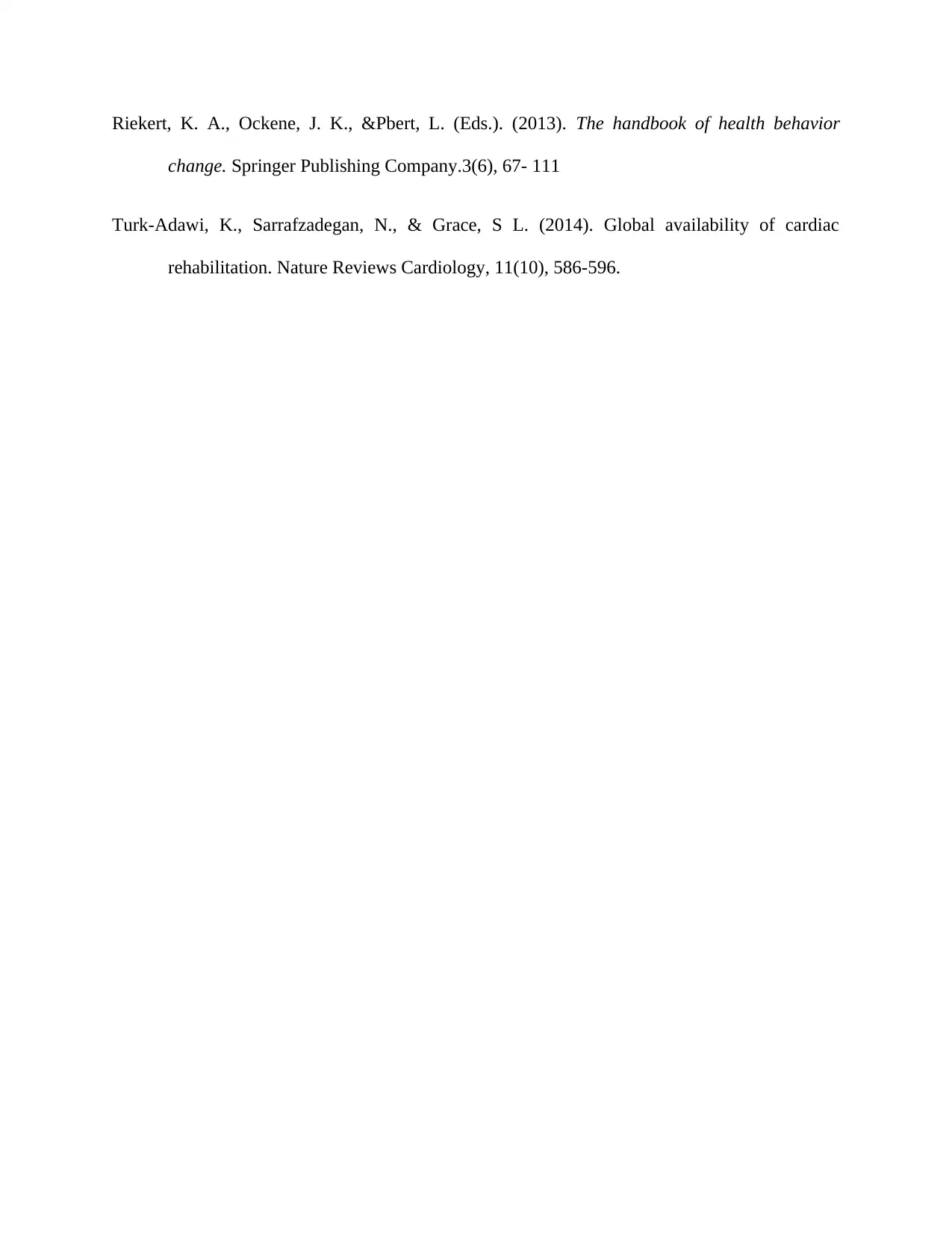
Riekert, K. A., Ockene, J. K., &Pbert, L. (Eds.). (2013). The handbook of health behavior
change. Springer Publishing Company.3(6), 67- 111
Turk-Adawi, K., Sarrafzadegan, N., & Grace, S L. (2014). Global availability of cardiac
rehabilitation. Nature Reviews Cardiology, 11(10), 586-596.
change. Springer Publishing Company.3(6), 67- 111
Turk-Adawi, K., Sarrafzadegan, N., & Grace, S L. (2014). Global availability of cardiac
rehabilitation. Nature Reviews Cardiology, 11(10), 586-596.
1 out of 12
Related Documents
Your All-in-One AI-Powered Toolkit for Academic Success.
+13062052269
info@desklib.com
Available 24*7 on WhatsApp / Email
![[object Object]](/_next/static/media/star-bottom.7253800d.svg)
Unlock your academic potential
© 2024 | Zucol Services PVT LTD | All rights reserved.





